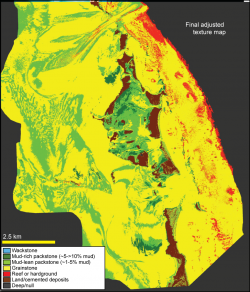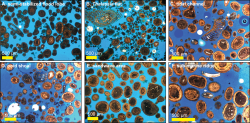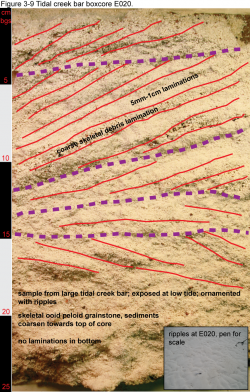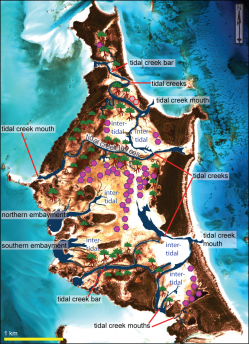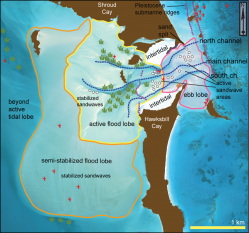Maaike Petrie Faulstich
Sedimentology of a Grain-Dominated Tidal Flat and Tidal Delta, Shroud Cay, Exumas, Bahamas
Sedimentary characteristics of grainy non-skeletal tidal flats along windward platform margins have not been described in modern environments. As such, they may also be misidentified or misclassified in the rock record. At Shroud Cay, such a grain-dominated tidal flat is sheltered from the high energy of the shelf by a ring of cemented Pleistocene and partly indurated Holocene eolianite islands separated by several narrow tidal passes. Mapping, extensive sediment sampling, and vibracoring have shown that, though the cemented island provide a barrier from the high energy of the shelf, a high degree of tidal energy still occurs behind this barrier as indicated by the overwhelmingly grainy nature of all of the tidal flat sub-environments (tidal channels, intertidal flats and levees, and supratidal flats).
The tidal flat itself contains several sub-environments. Intertidal flats comprise the majority of the tidal flat surface. These flats are characterized by patchy Scytonema mats overlying bioturbated peloid-ooid grainstones to packstones with cemented lithoclasts. Three main tidal channels dissect the tidal flat and allow diurnal flow. One of those tidal channels does not exit the tidal flat; instead, the channel dead-ends behind a cemented Holocene beach dune ridge along the eastern side of Shroud Cay. This particular channel exit point was open ~15 years ago, indicative of the rapidity of the beach dune ridge buildup and cementation. Peloid-ooid-skeletal grainstone tidal bars and peloid-ooid packstones fill much of the channel. Most of the channels are bordered by low-relief (<~30cm) grain-rich packstone levees often capped by red mangroves and algal mats. The interior-most supratidal parts of the flat, often in the lee of the windward Holocene ridge, are covered by a thick (5-~25cm) Scytonema pin-cushion algal mat underlain by grain-rich ooid-peloid packstones.
Ancient grain-dominated carbonate tidal flats and eolianite deposits like the ones at Shroud Cay have been identified as the reservoir rocks in some of today’s largest hydrocarbon fields. We document and compare subtle differences that exist between this grain-rich tidal flat and other grain-rich environments, as well as with muddy tidal flat deposits so that they may be accurately recognized in ancient deposits.
Key findings from my research include:
• Shroud Cay is carbonate grain dominated. Lack of mud is a result of an absence of mud producers and removal of mud from the system by tidal currents.
• Tidal flat, tidal delta, and eolianite deposits can be differentiated based on different types of sediments, sorting, and sedimentary structures.
• Different Pleistocene and Holocene age deposits can be differentiated based on different types of porosity, cementation, diagenesis, and sometimes, karstification.
• Influence of the underlying Pleistocene and Holocene cemented deposits leads to a highly heterogeneous facies distribution in the Recent unconsolidated sediments.
• The tidal flat development is linked to Holocene beach dune ridges development as they sheltered the tidal flat from the open ocean.
• New criteria for recognizing similar grain dominated tidal flats in the rock record.
•Shroud Cay shows clearly the high degree of facies heterogeneity in a grain-dominated carbonate margin and can be useful as an analog for similar settings in the ancient.
